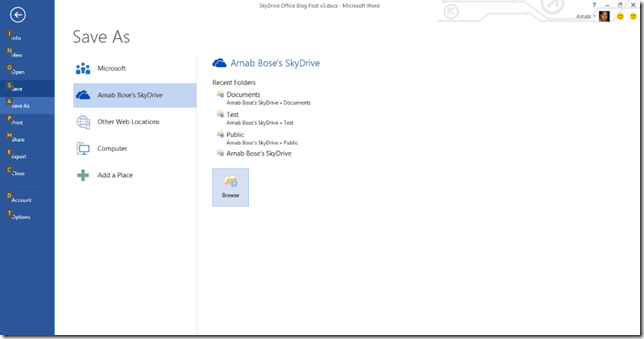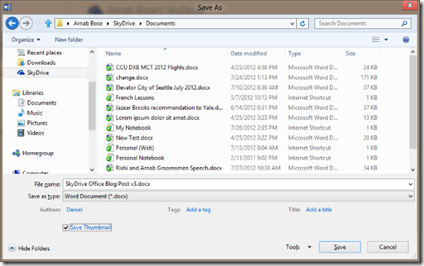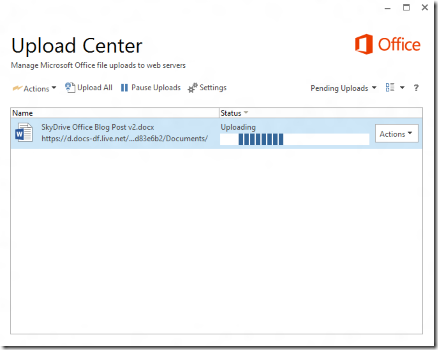Office and SkyDrive for Windows
Editor’s note: In one of our initial posts we discussed our efforts to connect Office more naturally to the cloud. This week we’ll elaborate on our services approach in the next Office, starting with today’s post about Office and SkyDrive integration. Daniel Fiordalis, Program Manager, and Arnab Bose, Senior Program Manager Lead join Office Next to discuss this area in detail.
 Hi everyone! By now folks have also been able to see that we’ve changed the default save location in Office to SkyDrive. We’re excited to talk about the change, and why it offers the best experience for storing, sharing and collaborating Office documents.
Hi everyone! By now folks have also been able to see that we’ve changed the default save location in Office to SkyDrive. We’re excited to talk about the change, and why it offers the best experience for storing, sharing and collaborating Office documents.
Saving to the Cloud
Going in we recognized that changing the default save location to SkyDrive was going to be critical to get right because it affects one of the most basic operations of our products. Saving to the cloud offers anywhere access to content through the new Office. This allows our users to move from device to device without having to worry where their content (or Office app) resides. Saving to the cloud also enables collaboration scenarios like coauthoring which aren’t possible when a file is just saved on your local machine.
However, there are things we take for granted every time we save to our local device. Things like easily being able to access the files while offline, or being able to use Windows Desktop search to find a file by name or content within. In fact, over 90% of all Office files are opened from File Explorer today. We knew that if we wanted to change where people saved, local file browse and search would still need to work, and saving to the cloud needed to be just as easy to understand as local file management is today.
If we look at current cloud based solutions, the answer seems simple. First, create an app to sync your files to the device you’re working on, then open those files locally. At first glance, this simplistic model seems to work. The major problem though, is opening these local files leaves you with just that—a local file. This approach doesn’t allow multiple people or devices to work on the file simultaneously and often causes conflicts. Syncing apps attempt to resolve these conflicts by making a duplicate of your content.
 With the next version of Office, we’ve created a no-compromise solution to these problems. Your documents will be saved to the cloud so you can easily share and collaborate with others. The integration between Office and SkyDrive for Windows mans your documents will sync locally and be cloud connected. Browsing your files on SkyDrive will not be affected by network latency or service availability.
With the next version of Office, we’ve created a no-compromise solution to these problems. Your documents will be saved to the cloud so you can easily share and collaborate with others. The integration between Office and SkyDrive for Windows mans your documents will sync locally and be cloud connected. Browsing your files on SkyDrive will not be affected by network latency or service availability.
You may have seen that SkyDrive for Windows is included in consumer editions of the next version of Office. In fact, if you’ve downloaded the Home Premium preview, SkyDrive is already on your computer! To get the app up and running, all you have to do is save a document to your personal SkyDrive. Once you have saved a document to SkyDrive or opened a document from the web site, the SkyDrive for Windows applications will automatically start syncing your content.
A Familiar Experience
Saving to SkyDrive enables many new advantages, but it does not require people to think differently about how to save or find their documents. The experience is very similar (almost identical) to what you are already used to – SkyDrive is offered as a choice in the Office application when selecting a save location. Like other default locations in File Explorer, such as the Documents Library, the SkyDrive experience is accessible from other Windows applications and available offline.
Taking your cloud with you
Once synchronization is complete and you are saving files to SkyDrive, you’ll have an up-to-date version of your content synced right to your local machine and available on SkyDrive! Whether you are using Office 365 Home Premium Preview, Office on Demand applications, or even other applications to edit documents, saving to SkyDrive will keep the local copy on your computer and the copy in the cloud synchronized for as long as you need it.
If you want to edit your documents from a different computer, just log in to the SkyDrive website with your Microsoft account. From here you can view and edit the up-to-date version of your documents via the Office Web Apps, the Office 365 Home Premium Preview or even Office 2010. If you save your changes back to SkyDrive, these changes will be synchronized back down to your computer(s) which are running the SkyDrive for Windows client application.
This is a major advantage of saving to your local hard drive because it gives you access to your documents wherever you sign into Office, and this approach is also a huge improvement over the cloud solutions that force you to stay online to do anything.
Managing local and cloud file synchronization
SkyDrive for Windows helps your Office files to stay current and cloud connected.
 When you edit your documents in the next version of Office and save them on SkyDrive, they are stored in the SkyDrive folder on your device and in the cloud at the same time. File uploads to SkyDrive are enabled via a background process which works asynchronously. Therefore, if you are working on your document from a coffee shop with a weak WiFi signal, you will be able to continue making changes to the file while uploads are in progress. This ensures that the performance and latency associated with editing Office documents is not affected by the bandwidth, latency or even availability of your network connection. In addition, when you open a local SkyDrive file, Office recognizes the file is stored in SkyDrive and connects to the cloud immediately—which means you get the latest, up to date copy of the document and if it’s a shared document, you can instantly see who else is currently editing the file and where they are typing. Especially for Office applications that support co-authoring, this is a major advantage because you’ll be able to coauthor documents with both the Office Web Apps as well as Office 2010 client applications.
When you edit your documents in the next version of Office and save them on SkyDrive, they are stored in the SkyDrive folder on your device and in the cloud at the same time. File uploads to SkyDrive are enabled via a background process which works asynchronously. Therefore, if you are working on your document from a coffee shop with a weak WiFi signal, you will be able to continue making changes to the file while uploads are in progress. This ensures that the performance and latency associated with editing Office documents is not affected by the bandwidth, latency or even availability of your network connection. In addition, when you open a local SkyDrive file, Office recognizes the file is stored in SkyDrive and connects to the cloud immediately—which means you get the latest, up to date copy of the document and if it’s a shared document, you can instantly see who else is currently editing the file and where they are typing. Especially for Office applications that support co-authoring, this is a major advantage because you’ll be able to coauthor documents with both the Office Web Apps as well as Office 2010 client applications.
While offline, Office will be able to create, save and open your files from the local SkyDrive folder. You’ll see notifications within Office letting you know if you’re working offline. If needed, Office will alert you if there are changes to your file that are pending upload to the cloud. Your files are still being saved locally though, so you don’t need to worry about losing any data. In fact, you can exit your Office apps all together and whenever you get your connection back, Office will upload your changes to the cloud automatically!
Smart Sync
Using Office and SkyDrive to sync your files has great benefits for bandwidth utilization and battery life. For example, if you are working on a 50 MB PowerPoint presentation and decide to insert a new bullet point, Office will only upload that single bullet point. The same goes for downloading updates from the cloud. We call this partial file upload and partial file download and it’s enabled via the MS-FSSHTTP protocol.
SkyDrive will delegate all Office file types over to Office for syncing. This way all of your Office documents will benefit from partial file download and upload. You may notice the Upload Center balloon show up from time to time. The Upload center takes care of any uploads and downloads whenever there isn’t an Office app open. It has specialized UI to help do basic upload management tasks associated with Office files. The balloons show up to let you know if a file upload has gone pending due to lost connectivity or if it has failed and needs your attention.
Wrapping up
Saving to the cloud has never been easier. You’ll get all the benefits of easy sharing and collaboration by having your work in SkyDrive without sacrificing offline access and the ability to search on all your devices. This means you can get to the content that matters most to you anytime and anywhere.
Thanks for reading this far, we’re really excited for you to try it out and let us know what you think.



